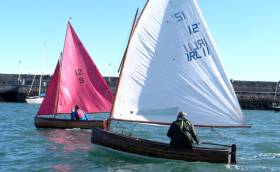Displaying items by tag: 12–ft Dinghy
Cora Becomes International 12–ft Dinghy Champion at Royal St. George Event
The International 12 foot and DBSC 12 foot dinghy Irish championships were scheduled, as reported earlier on Afloat.ie, for Dun Laoghaire for the weekend of 10th September 2017. However, the weather forecast was very poor, so, the Royal St. George Yacht Club decided to postpone the event for one week. The two classes of boats have identical hulls, but the International 12 has all the sail area in the mainsail, while the DBSC version has a small jib. The International 12s were approved equipment for the 1920 and 1928 Olympic Games.
Download 2017 Championships results below
The weather on 17th September was ideal, with bright sunshine and a force two breeze from the north. In race one, the International 12s pulled away from the DBSC 12s, with Mark Delany’s Cora a half boatlength ahead of George Millar’s Pixie, as they approached the windward mark. However, Cora was unable to lay the mark, and was forced to gybe away. This handed the lead to Pixie, and dropped Cora to third place behind Gavan Johnson and Gail Varian’s Albany. It took Cora the whole of the next lap to regain her second place. In race two Cora got the best start, and at the windward mark she led from Paul and Tom Gillespie’s Calypso. And the order remained thus until the final beat to the finishing line, when Pixie and Albany managed to overtake Calypso.
The fleet came ashore for a sociable lunch. After lunch, a new course was laid with longer reaching legs, and in the third race, Cora and Albany led around the first windward mark, but the superior offwind speed of the International 12s brought Pixie up into second place, and they retained this order to the finish. In the final race, Pixie needed to win to retain her championship title. Calypso was now being sailed single handed, and she got the best of the start, and held second place behind Cora at the windward mark. Pixie’s superior offwind speed came to the fore again, and she slipped into second place, which she retained to the finish.
Thus, Cora becomes the International 12 ft. dinghy champion and Albany retains her title for as Dublin Bay Sailing Club 12 Ft. dinghy champion.























